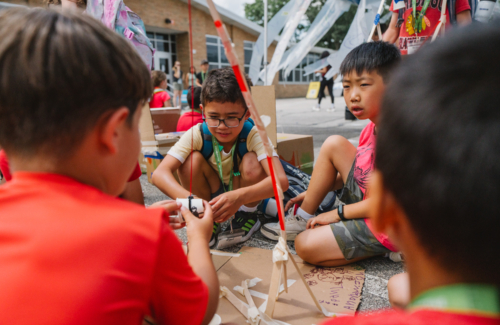3 Entertaining Outdoor STEM Activities to Try

Science, Technology, Engineering and Mathematics (STEM) is an integral part of any robust education and should be taught in every school. But classrooms aren’t the only places where developing minds can learn valuable STEM lessons.
The great outdoors provides ample opportunities to learn about STEM concepts that spark curiosity and foster hands-on exploration. From the wonders of natural engineering to the nitty-gritty science of how our world works, a trip outside your front door can offer just as much knowledge as any lecture or textbook.
Next time you’re planning a day in nature with the little ones, give these engaging outdoor STEM activities a try!
#1 Go On a Bug Hunt
There are over one million known species of insects worldwide, and it’s estimated that there may be nine million more we’ve yet to identify. The first step to finding them? Getting out into nature.
Next time you’re in the mood for an outdoor adventure, take the kids on a bug hunt. Insects abound offer valuable insights into your local environment and wildlife. For example, discovering a variety of butterflies might indicate a healthy ecosystem with diverse plant life.
Plus, you don’t need to catch them—you can simply take pictures to learn about their unique quirks using a bug identification tool.
If you do want to take a few home for observation, they’re simple enough to wrangle and house using:
- A small net
- A bug box
- Some leaves or crumbs for them to snack on
Be warned: bugs are crafty and skittish. If your little ones are having trouble finding a creepy crawler, try looking under rocks, in old logs and around sources of water to increase your chances of finding an insect that sparks interest.
#2 Make a Sundial
Before the days when everyone had clocks in their pockets or strapped to their wrists, people relied on the sun to approximate the time. To provide your kids with an engaging lesson in history and STEM, transport them back to ancient times by constructing a sundial together.
To get started, you’ll need a few basic materials:
- A paper plate
- A few pencils
- A rock or other heavy object
- A compass
- A clock
- The sun
Obviously, this one can only be done on a sunny day—but that’s the best time to get outside anyway! To make your sundial:
- Write 12 anywhere on the outer edge of your plate—this will be your reference point for noon.
- Pierce a pencil directly into the center of the plate. This will act as your gnomon, the piece responsible for casting a shadow across the sundial’s face.
- At exactly noon, place the sundial outside in a wide-open area that will get sunlight for hours to come. Ensure your 12 is pointing due north and the shadow from the gnomon falls directly on it.
- Put a rock on the plate to prevent it from blowing away.
- In one hour, return to your sundial and mark a 1 wherever the shadow is hitting.
- Continue to update your sundial hourly—adding 2 where the shadow lands at 2 pm, 3 where it falls at 3 pm and so forth.
- Go until the sun is down for the day, then return after it rises to fill the morning hours.
Crafting a sundial gives your child a first-hand look into the inner workings of standardized time. Having spent our whole lives reading the time from clocks and screens, we often forget that our method of timekeeping is based on the rotation of the Earth relative to the sun.
This hands-on experience encourages kids to contemplate how humans have historically leveraged natural phenomena, like the Earth’s orbit and the sun’s position, for our daily lives. Understanding these natural processes can deepen their appreciation for the world around them and foster critical thinking skills as they reflect on the relationship between science, technology and human civilization.
#3 Clip and Clone Plants
Most kids know plants grow from seeds, but fewer understand that you can also clone flowers, shrubs and other greenery from stems, leaves and roots.
For this fun project, take a nature walk in your local park, forest or other green space. Find some interesting-looking plants you’d like to clone, and trim off a leaf or two from inconspicuous spots—don’t worry, it won’t hurt them. Then, take the leaves back to your home and:
Cut them into two to four-inch segments.
Insert the parts of the segments that were closest to the leaf’s stem one to two inches into a tray filled with potting soil.
Place a plastic bag over the tray and put it somewhere sunny for a few weeks.
Monitor your clones, and see when they start to grow. Once they’ve rooted and begun to flourish, you can transplant them to a bigger pot or your garden.
Cloning plants gives kids insight into the basics of biology and cellular reproduction, which shows them that there’s more to horticulture than watering seeds. This experiment teaches them some of the techniques farmers and other agriculturalists use to produce healthy, robust plants.
Send Your Kids to Camp Galileo For Even More Outdoor STEM Fun
These activities are all exceptional ways to get outside, learn about STEM concepts and engage your children’s curiosity. There are even more amazing opportunities to play and learn waiting at Camp Galileo.
From kindergarten to 8th grade, Camp Galileo provides kids with hands-on, educator-led STEAM activities, outdoor adventures and more. We also provide a Counselor In Training program for 8th-10th graders at select locations. Collaboration and confidence are key components of the Camp Galileo ethos, and we encourage all our campers to use the lessons they learn to make the world a better place. Likewise, we teach resilience and out-of-the-box thinking in every game and project to elevate the traditional fun of summer camp into an unforgettable experience.
With more than 70 camp locations across the United States, find a camp near you and enroll your child today—the mysteries of STEM are waiting to be uncovered.
Sources:
- Hereward College. “At-Home STEM Activities: Make Your Own Sundial”. McAuliffe-Shepard Discovery Center. https://www.hereward.ac.uk/.
- Lerner Rosie, Welch-Keesey Mary. “New Plants From Cuttings (HO-37 W) (HO-37-W)”. Purdue Extension Publication. 1 September 2001. https://www.purdue.edu/.
- Royal Entomological Society. “Facts and Figures”. https://www.royensoc.co.uk/.
- Ralls Eric. “Mystery solved: When butterflies evolved and what plants they used for food”. Earth.com. 15 May 2023. https://www.earth.com/news/mystery-solved-when-butterflies-evolved-and-what-plants-they-used-for-food/.

